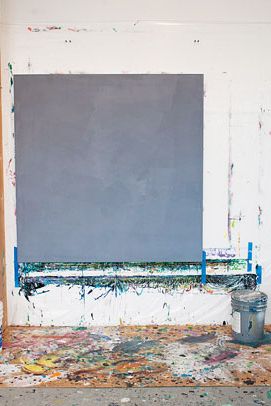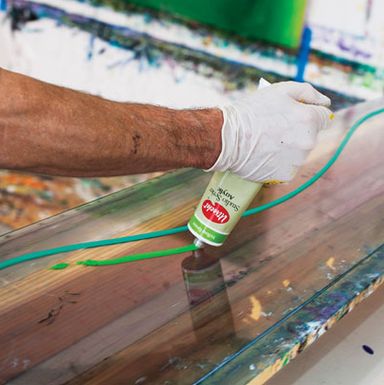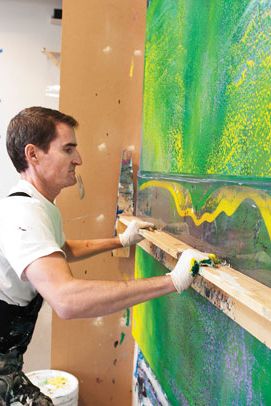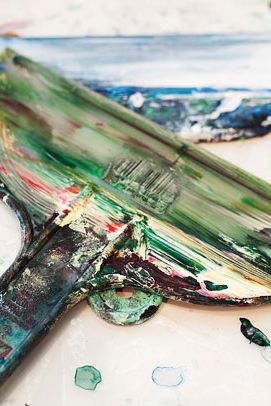Saltz: Make Me a Faux Gerhard Richter Painting
I love art, but I hate the astronomical prices it sells for. My skin crawls when I read about auctions, and every year they get grosser. Last month, a living-artist record was set when a 1994 abstract Gerhard Richter painting was sold for $34.2 million. Like a lot of these purchases, the sale was about a collector trying to make art history by spending money. Or big-dick-waving. Ugh.
I want to own art like this, but IÔÇÖm not rich, and I also think itÔÇÖs a conflict of interest for a critic to own work that he or she may write about. (Reviews can affect market value.) So, last winter, I put out a call on Facebook. IÔÇÖd pay anyone $155 plus the cost of materials to make me a perfect fake by Richter, Ryman, Flavin, Fontana, Du┬¡champ, Hirst, Guyton, or Agnes Martin. (Why $155? ItÔÇÖs enough money to me that the painting had to be worth it, and 55 is a funnier number than 50.)
You canÔÇÖt just call up a guy and order an ersatz Hirst or RichterÔÇöunless you are seeking a flat-out forger, but those folks donÔÇÖt work for $155 and their numbers arenÔÇÖt listed. Besides, in the art world, noncriminal fakes arenÔÇÖt news. We donÔÇÖt even call them ÔÇ£fakes.ÔÇØ We prefer the term ÔÇ£appropriation,ÔÇØ whereby a new artwork incorporates or reproduces another. Copyists lie on a continuum: At one end, you have extremely original artists (Richard Prince, Elaine Sturtevant) who use the old to make something new. At the other, you have people deceiving buyers. In between, you have artists who merely make covers, trying to get attention; slipstream behind the famous; and offer simplistic observations. Plus some who are just goofing around.
A lot of those folks turned up, and three came through. Daniel Maidman made me a peppy, near-perfect Hirst spot painting. The artist Vincent Zambrano made me a pretty good Guyton. (Guyton produces his art on ink-jet printers, and ZambranoÔÇÖs printer was too small to conjure the surfaces and scale-shifts of the real thing.) Then came Stanley Casselman, who asked, ÔÇ£Which Richters do you want?ÔÇØ Intrigued, I answered, ÔÇ£Any abstract from the past twenty years.ÔÇØ He vanishedÔÇöthen, months later, e-mailed images labeled ÔÇ£Your Richters.ÔÇØ
He hadnÔÇÖt copied one painting: These were originals in the manner of Richter. All had nifty squeegee sluices of blurry paint, but they were either too pretty or illusionistic or atmospheric. I sent Stanley an e-mail saying they didnÔÇÖt make the cut, and he disappeared again. In September, he sent new imagesÔÇöso close they freaked me out. We made a date and met at his Jersey City studio. It was clear that he knew this was a lark yet took it seriously.┬á
The examples of StanleyÔÇÖs own art that I saw are nothing like RichterÔÇÖs. TheyÔÇÖre highly crafted abstract minimalist works. Not to my taste, but done impeccably. Which turns out to be key for copying: He is a practiced artist who knows how to handle paint.
When Stanley opened his door, I saw what looked like 50 large Gerhard Richters. I immediately had fantasies of getting rich, of opening a Fake Richter shop with him. Then I started looking more closely. All of the paintings seemed Richterian, but many had an Impressionistic, un-Richterian prettiness. Many looked too thought-out. Accidents looked intentional rather than discovered. His decisions stood out instead of taking me by surprise. RichterÔÇöwho applies paint in scrims, in layers that emerge through one anotherÔÇöcontrols accident with a physical intelligence and subtle changes of direction and touch; his decisions are in an incredible call-and-response relationship to accidents. His abstract paintings look like photographs of abstract paintings. This creates glitches in your ┬¡retinal-cerebral memory, so that you perceive this uncanny space between abstraction, accident, photography, process, the nature of paint, and painting. These didnÔÇÖt.
Then, suddenly, one made my heart beat faster. Stanley grimaced. ÔÇ£That oneÔÇÖs not my best,ÔÇØ he said. ÔÇ£YouÔÇÖre wrong,ÔÇØ I told him. Then another struck me. He winced again, saying, ÔÇ£ThatÔÇÖs a reject that had been cut out from another work.ÔÇØ Then I understood that only when Stanley stopped thinking he was making a Richter could he make one. We had a deal: Stanley signed his name prominently on the back of each, and I paid him, put them in my car, and drove home.
I donÔÇÖt think Stanley understands that he could get pretty rich making these things. I suspect he could get $8,000 a pop. IÔÇÖll bet he wonÔÇÖt: Although artists say they want to make money and get attention, almost all of them only want those results from doing their own thing. Whereas I love living with my faux Richters, even if neither looks exactly like the real deal. Very close is close enough for me (and as close as IÔÇÖm going to get). Maybe itÔÇÖs better: I love that thereÔÇÖs no big-dick trophy-art baggage around them. Moreover, they trigger enough memory of actual Richters that they become real enough. IÔÇÖm not making a comment about the market or smirking that some work can be reproduced. WeÔÇÖre not creating fake provenances or aging materials: Casselman signs his own name. These are knockoffs, flints that spark, reminders, whatever. If anyone worries that they will one day enter the market as the real thing, IÔÇÖll decree in my will that they should be burned.
The final thing I learned is embarrassing, given how much I hate market chatter: IÔÇÖve caught the collecting bug. IÔÇÖve arranged for more Richters by other artists. Ditto Guyton and Hirst. IÔÇÖve got a Kara Walker cutout on order. Calders, Duchamps, Rothkos are all on the way. My wife is worried. So am I. Oh my! IÔÇÖve got a case of little-dick art.┬á┬á┬á┬á┬á┬á┬á┬á┬á
Click through the slideshow to see how Casselman created a Richter in two hours.
*This article originally appeared in the December 3, 2012 issue of New York Magazine.


How Stanley Casselman did it.
First, Casselman covers the gessoed canvas with an underpainting.
Photo: adam nadel
Here, in a shaggy V-shape.
Photo: adam nadel
Then he loads up a Plexiglas squeegee, which he made himself, with up to half a gallon of acrylic paint.
Photo: adam nadel
Casselman added wheels, so he can roll it down a track. ÔÇ£In the documentary Gerhard Richter Painting, Gerhard was struggling with the squeegee,ÔÇØ expla...
Casselman added wheels, so he can roll it down a track. ÔÇ£In the documentary Gerhard Richter Painting, Gerhard was struggling with the squeegee,ÔÇØ explains Casselman. ÔÇ£My setup keeps it perpendicular.ÔÇØ He makes a pass over the canvas, varying the pressure so that parts of the underpainting remain exposed.

He cleans the squeege.
Photo: adam nadel
He reloads it.
Photo: adam nadel
And repeats up to 40 times.
Photo: adam nadel
He sometimes turns the painting between passes.
Photo: adam nadelSoon, fissures revealing the colors underneathÔÇöÔÇ£the defining element of RichterÔÇÖs languageÔÇØÔÇöare created.
Photo: adam nadelThe later passes are meant to bring everything together while leaving some roughness.
Photo: adam nadelÔÇ£You have to decide fast whether itÔÇÖs is finished,ÔÇØ says Casselman. ÔÇ£After twenty minutes, the texture of the paint starts to change.ÔÇØ Then? ÔÇ£I wait t...
ÔÇ£You have to decide fast whether itÔÇÖs is finished,ÔÇØ says Casselman. ÔÇ£After twenty minutes, the texture of the paint starts to change.ÔÇØ Then? ÔÇ£I wait till it sings.ÔÇØ And if it doesnÔÇÖt? ÔÇ£So fucking what? I spent two hours,ÔÇØ says Casselman. ÔÇ£IÔÇÖm sure RichterÔÇÖs pumping out ten a day.ÔÇØ
-Miranda Siegel
Photo: adam nadel














